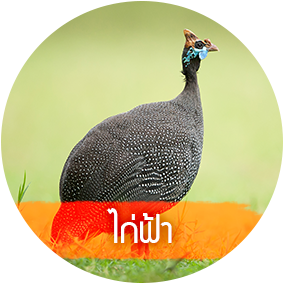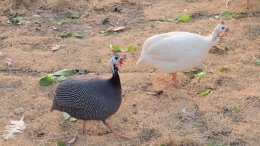GUINEAFOWL
5591 Views |

The insect and seed-eating, ground-nesting birds of this family resemble partridges,
but with featherless heads, though both members of the genus
Guttera have a distinctive black crest, and the vulturine guineafowl has a downy brown patch
on the nape. Most species of guineafowl have a dark grey or blackish plumage
with dense white spots, but both members of the genus Agelastes lack
the spots (as do some Wild variants of the helmeted guineafowl).
While several species are relatively well known, the plumed guineafowl and the
two members of the genus Agelastes remain relatively poorly known.
These large birds measure from 40–71 cm (16–28 inches) in length,
and weigh 700–1600 grams or 1.5-3.5 pounds.
Guineafowl species are found across sub-Saharan Africa, some almost in the entire range,
others more localized, such as the plumed guineafowl in west-central Africa and
the vulturine guineafowl in north-east Africa . They live in semi-open habitats such
as savanna or semideserts, while some, such as the black guineafowl,
mainly inhabit forests. They perch high on treetops when reared in the extensive way.
The helmeted guinea fowl has been introduced in East Africa, the West Indies, the United States,
Britain and India, where it is raised as food or pets.
Guineafowl is commonly eaten in parts of Africa (notably
Ghana especially the northern part of the country, Nigeria and Botswana),
India and the United States (notably in the state of Georgia).
It is consumed at Christmas in some parts of Central and Northern Europe
(notably in Belgium and the UK). It is also eaten in Italy and in Vojvodina,
a part of Serbia. Guineafowl meat is drier and leaner than chicken meat and has a gamey flavour.
It has marginally more protein than chicken or turkey, roughly half the fat
of chicken and slightly fewer calories per gram.
Guineafowl eggs are substantially richer than chicken eggs.




